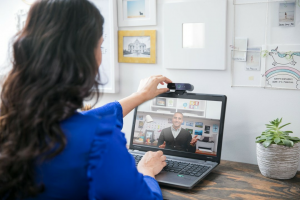The experience of a dedicated, purpose-built webcams had never been realized untill people were forcibly locked down at homes – thanks to COVID-19. For decades together, computer literates (even onlookers) had been content with the embedded cams, mostly assuming that it was the best. Cometh external webcams, and the experience of virtual meetings went places. Here is an exposition by Varun Nair, B2B Products Head-India & SWA, Logitech Electronics.
……………………………………………
 The global pandemic has permanently changed the way we work and the way we live. Flexible working and ‘work from home (WFH)’ have quickly become the new norm. Few people could have predicted the way video conferencing has taken over the business world and become an essential part of daily life for millions of people.
The global pandemic has permanently changed the way we work and the way we live. Flexible working and ‘work from home (WFH)’ have quickly become the new norm. Few people could have predicted the way video conferencing has taken over the business world and become an essential part of daily life for millions of people.
There is a catch. The quality of video technology is crucial. If the experience of attending video for meetings is poor, people are more likely to abandon it in favour of meeting in person or not at all. But if the experience is great – the video and sound are clear, people are easy to see, the meeting feels like being there in person – well, that’s the key to enterprise-wide adoption. And this is why a webcam makes such a big difference.
Limitations with Embedded Computer Cameras
 Unfortunately, many people working remotely have had to make do with substandard performance and capabilities from the video cameras embedded in their laptops or phones. With embedded cameras, the quality is highly variable.
Unfortunately, many people working remotely have had to make do with substandard performance and capabilities from the video cameras embedded in their laptops or phones. With embedded cameras, the quality is highly variable.
One of the key reasons is that over the years, laptops have become ever thinner, stretching the display to the edge of the hardware with minimal bezels. One of the most difficult problems facing laptop webcams is the limited space available for better hardware. Super thin Laptops often mean super bad webcams as the physical camera itself has small sensors and smaller apertures.
The limitations of embedded cameras also undermine the benefits of video collaboration. Problems arise from poor lighting, bad angle, and poor resolution or clarity. If the camera isn’t positioned just right, the user is in a dark room, there’s a bright window behind them, or there is a strong light on one side, it can be difficult for other people to see that person clearly. Embedded cameras do a poor job of compensating for these conditions.
How to Deliver a Superior Meeting Experience with a Purpose-Built Webcam
The experience with business-grade webcams is generally outstanding and highly predictable. These webcams are purpose-built for the job.
 A business-grade webcam will include a number of features that enhance the image. One of the most important is the ability to compensate for poor lighting. Logitech Brio for instance uses RightLight 3 and high dynamic range (HDR) technology to highlight the subject (rather than the background), so the speaker is always clearly visible.
A business-grade webcam will include a number of features that enhance the image. One of the most important is the ability to compensate for poor lighting. Logitech Brio for instance uses RightLight 3 and high dynamic range (HDR) technology to highlight the subject (rather than the background), so the speaker is always clearly visible.
The ability to change field of view (FOV) and position the camera in a more favorable angle is another valuable feature. It allows users to crop out distracting backgrounds, perfectly frame themselves, or capture the entire scene if needed.
Another consideration: integrations and certifications. Webcams that are certified for video conferencing software like Google Meet, Microsoft Teams, and Zoom help ensure problem-free meetings. Certifications like these are enormously beneficial to IT as they empower end users and reduce calls to the helpdesk.
Providing a consistent toolset for employees – including video conferencing tools like webcams and headsets – addresses one of IT’s priorities: reducing support calls. This is one reason companies invest in enterprise solutions. The variability in experience and quality of embedded cameras not only leads to more user complaints, more calls, and more helpdesk tickets, it also increases the time IT personnel spend troubleshooting.





















